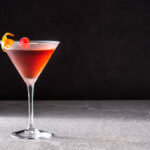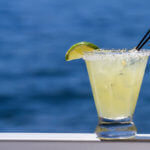When pairing a meal or a snack with the right beverage, it’s easy to reach for a beer or glass of wine. But cocktail and food pairings are a bit trickier, since mixed drinks run such a wide range of flavors.
A great place to start is with classic cocktails. Many of these historic favorites are simple to make, with just a few ingredients. And their simplicity makes them easier to pair with the right dishes.
Here are six classic cocktail and food pairings that you can explore to open up a new world of flavors.
Old Fashioned with a Steak
The classic old fashioned cocktail combines bourbon’s richness with sugar, aromatic bitters, a cherry, and an orange peel.
The warmth and sweetness of an old fashioned goes well with umami-heavy flavor, which is why it pairs so well with steak—especially if it’s wood-fired. The smoke from a wood grill is a natural companion to bourbon aged in wooden casks.
Tip: When making your old fashioned, substitute a dark wine-colored Luxardo cherry for the candy-like Maraschino cherry. It’s a major upgrade!
“Steak with a whiskey cocktail is one of my favorite things! High rye or spicier whiskeys go with red meat a lot better than sweeter versions.”
Stuart Stein, Escoffier Chef Instructor and Co-Owner, Transformation Spirits
Champagne Cocktail with Eggs Benedict
Tart and crisp, champagne is a natural foil to a meal with plenty of salt and fat. A champagne cocktail brings a little sweetness to the mix. And it couldn’t be simpler to make—a sugar cube, a dash of bitters, and a flute full of champagne, garnished with a lemon peel.
The added sugar pairs well with both sweet and salty dishes. This drink would be ideal with a fruity dessert, but it also pairs well with eggs and salty Canadian bacon covered in rich, creamy hollandaise sauce.
“Bubbly things balance fatty, so look for a cocktail with carbonation to go with a fatty meal.”
Stuart Stein, Escoffier Chef Instructor and Co-Owner, Transformation Spirits

Manhattan with Rack of Lamb
The Manhattan combines warming bourbon with sweet vermouth, bitters, and a cherry, served straight up in a martini glass.
A succulent rack of lamb pairs beautifully with a Manhattan. Lamb is often grass-finished, which gives the meat a well-balanced, slightly earthy flavor. And if the outside is well-salted, it will have a lovely crunch that will complement a sweet, silky cocktail.
While contrasting flavors pair well, Escoffier Chef Instructor Stuart Stein explained that complementary flavors can also mix well together. This technique is called mirroring, and it brings out the similarities in both dishes. One way to get this effect is to cook with some of your cocktail ingredients.
Lamb is often served with a pan sauce made from aromatics (shallots, onion, garlic), fat (butter or cream) and an acidic alcohol (wine, cider, sherry). By making a pan sauce using your Manhattan’s sweet vermouth in place of the wine, you’ll bring the flavors of the lamb and the cocktail together.

Gin Martini with Seafood
The simple combination of gin, dry vermouth, and lemon peel is an exceptional choice when you’re snacking on a shrimp cocktail or enjoying raw oysters. Gin is herbaceous and light, which pairs well with the more delicate flavors found in des fruits de mer.
Different gins have distinct flavor profiles, although all include the liquor’s signature piney juniper. Other flavors often include citrus like lemon or orange, anise, coriander, cardamom, and licorice.
The natural citrus of gin mingles well with buttery seafood. Its astringency cuts through that thick mouthfeel of the seafood for a fresh palate with every bite. Try scallops, lobster, or crab for a great flavor contrast with your martini.
Martinis also blend well with raw oysters on the half shell. Or you can steam oysters, clams, or mussels in gin or vermouth for a great complementary flavor.
If you prefer your gin a bit more toned down, try a classic gin gimlet instead! A gimlet is a blend of gin with fresh lime juice and just a touch of simple syrup for sweetness.
“Brightness and acidity balance fat. The botanicals in the gin with nice bright acidity from the lime juice [in a gimlet] will balance fatty lamb, a fatty steak, or a fatty piece of salmon.”
Stuart Stein, Escoffier Chef Instructor and Co-Owner, Transformation Spirits
Negroni with Neapolitan Pizza
A Negroni is a slightly bitter cocktail, made from equal parts gin, red (sweet) vermouth, and Campari, served on the rocks. Campari is an herbal, slightly medicinal aperitif. It’s bright red, which gives the Negroni its signature hue.
Since this drink is on the bitter side, it needs to be paired with food rich and strong enough to not be overpowered. A salty Neapolitan pizza with rich sauce and plenty of mozzarella is an excellent option. With pizza hailing from Naples and Negronis from Florence, this is a decidedly Italian meal!

Margarita with Spicy Mole
There’s a reason that margaritas became a go-to drink with Mexican food. There’s nothing like a cold, citrusy drink to break through the spice of aromatic Central American chiles and spices.
“Mole” comes from the Nahuatl word m?lli, and simply means “sauce.” There are dozens of different mole varieties, ranging from mild to spicy. Mole rojo is one of the spicier variations, getting its heat from dried chiles like Pasilla, Nuevo Mexico, California, and Guajillo.
Earthy tequila and bright citrus help to cut through the sauce’s heat, which is why a classic margarita pairs so well with this dish.
“Sweet balances salty, fatty, and spicy. The sweet and sour of the classic margarita balances that spiciness [of Mexican food].”
Stuart Stein, Escoffier Chef Instructor and Co-Owner, Transformation Spirits

Have Fun with Flavor!
Once you know the flavor profiles of different dishes and cocktails, it makes pairing them up much easier! But how to learn?
Culinary Arts students at Auguste Escoffier School of Culinary Arts will dive into the components of flavor—taste, aroma, and mouthfeel—throughout their programs. With tools like the Escoffier Flavor Wheel, they’ll explore which flavors contrast with and complement each other, which they can then apply to food and cocktail pairings.
In the Hospitality & Restaurant Operations Management program, students can study Beverage Service Operations with skilled instructors like Stuart Stein. In addition to the management side of the bar, this course includes lessons in menu planning and inventory.
Find the right program to get you closer to your goals, whether that’s managing a beverage program, becoming a master culinarian, or simply planning the perfect cocktail and drink pairings as a home chef!
To learn more about food and drinks, read these articles next:
- 4 Tips for Promoting Happy Hour in Your Restaurant
- Everything You Need to Know About Functional Foods
- Gen-Z Food Habits and Influences
This article was originally published on May 19th, 2017, and has since been updated.

